Oscar-Claude Monet (1840-1926) was a French painter and leader of the impressionist movement. His work, which emphasized light brush strokes, bright colors and nature, is considered the foundation for modern and contemporary art. Monet was a pioneer of painting outdoors, known as the en plein air, an aim to capture reality, nature, and the changing of color. His most well-known paintings today are his serene water lily paintings.
Nineteenth century Impressionist Claude Monet was a groundbreaking tour de force in the development of expressive art. Throughout his long life Monet would progress from drawing amusing caricatures of friends to capturing the elusive natural scenes, in various attitudes of light and color.
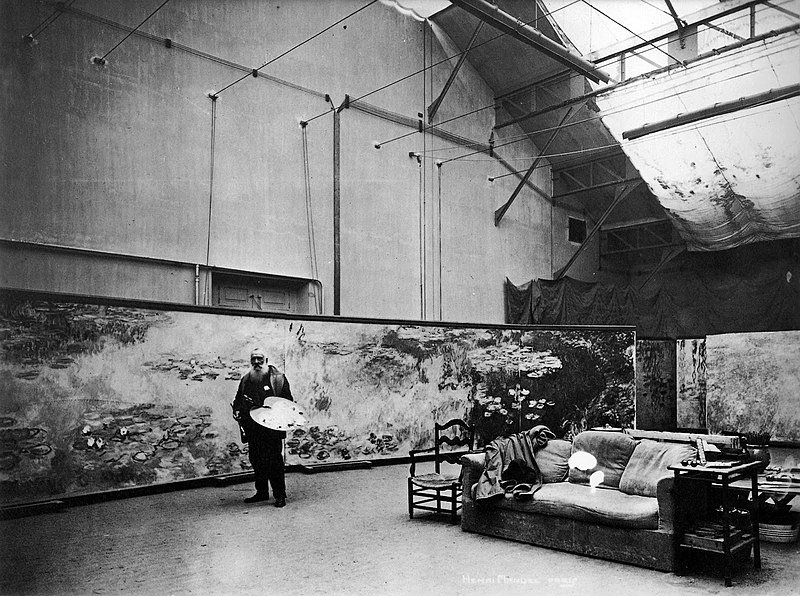
He recorded his findings faithfully, from the Pairs railway station to the incandescent beauty of his later paintings based on gardens. He created a big collection at the Giverny in northeastern France. Frequently exhibited and successful during his lifetime, Monet’s fame and popularity soared in the second half of the 20th century.
At the time he had become one of the most famous painters in the world. A source of inspiration, a master in his own right. To be looked at by other artists as a genius that should be respected for his many talents by striving to translate his unique perception of the natural world directly to the canvas. Claude Monet was instrumental in forging an entirely new direction for the world of art.
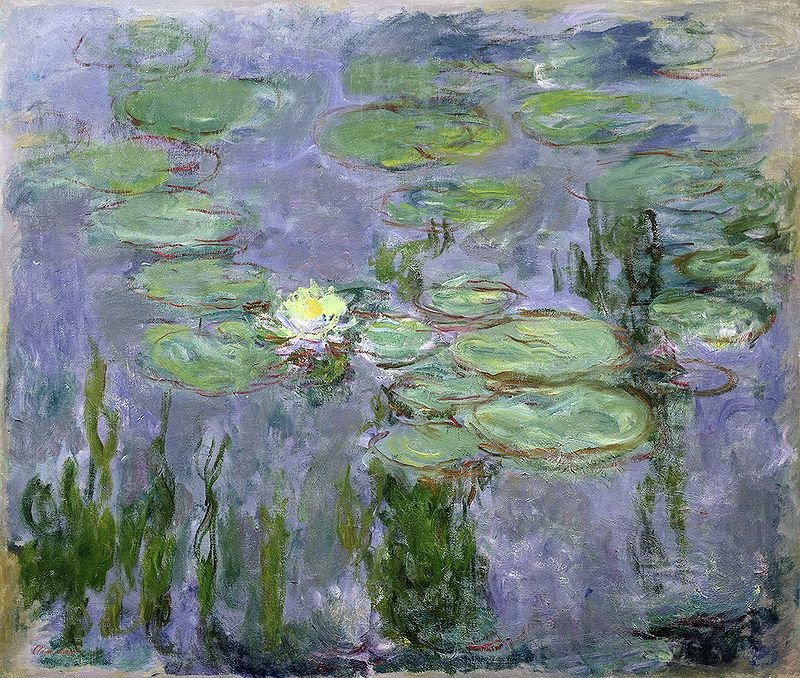
Nympheas, 1915, Musee Marmottan onet, Paris
Early Years 1845 –1870
When Claude Monet was 11 he attended an art focused secondary school in his hometown of Le Havre, taking beginning drawing classes from Jacques-Francois Ochard. A few years later Monet studied the art of landscaping from a local painter Eugene Boudin, who also acclimated the young artist to paint in the open air, to capture nature in the moment.
Under the informal teachings of the landscape master Johan Jongkind, Monet unlocked his talent and developed a style that we still love to this day. The style that has inspired generations.
One of the first paintings completed by Monet in 1858, was a realistic landscape named “View at Rouelles, Le Havre”. A lifelike scene which bears little resemblance to his later works. The artist’s early efforts pay homage to the Realist school of art that was the biggest influence during his childhood.
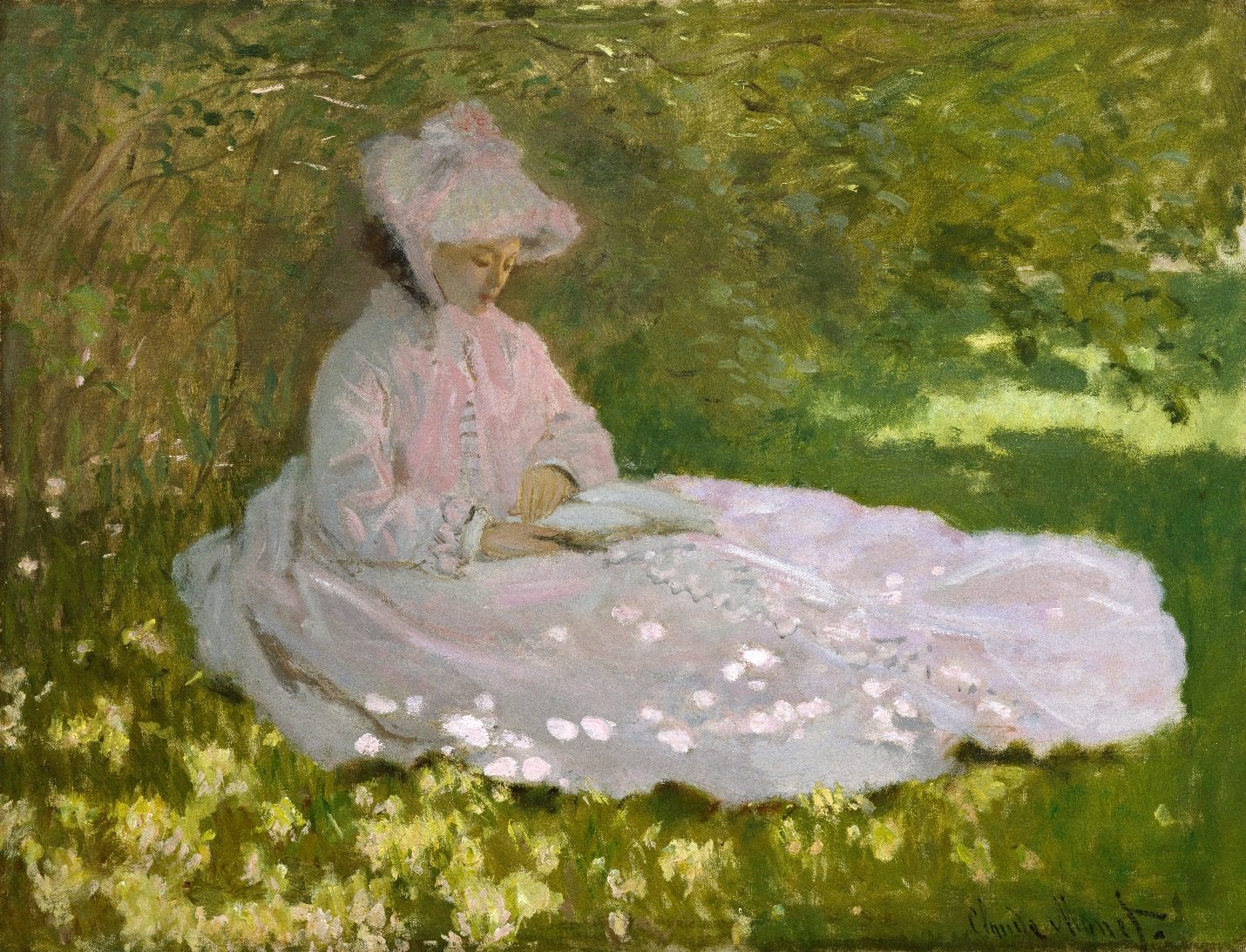
Springtime, 1872, Walters Art Museum, Baltimore
Realistic artists, such as Gustave Courbet, focused on accuracy in depicting their artwork. Which often consisted of working-class figures and unembellished, natural scenery. During this period from his late teens to early 20’s, Claude Monet spent time in the Louve in Paris where he met contemporary painters such as Edouard Manet. While other artists sought to improve by coping other artists, Monet prefered to sketch what he saw.
In 1861 Monet was drafted into the Les Chasseurs d’ Afrique a light cavalry unit headed to Algeria. During his long year of duty he only had a few opportunities to paint. He only produced one landscape, few sketches, and some military portraits.
While none of these survived his service, he would call upon his memories of light in Algiers when creating future artwork.
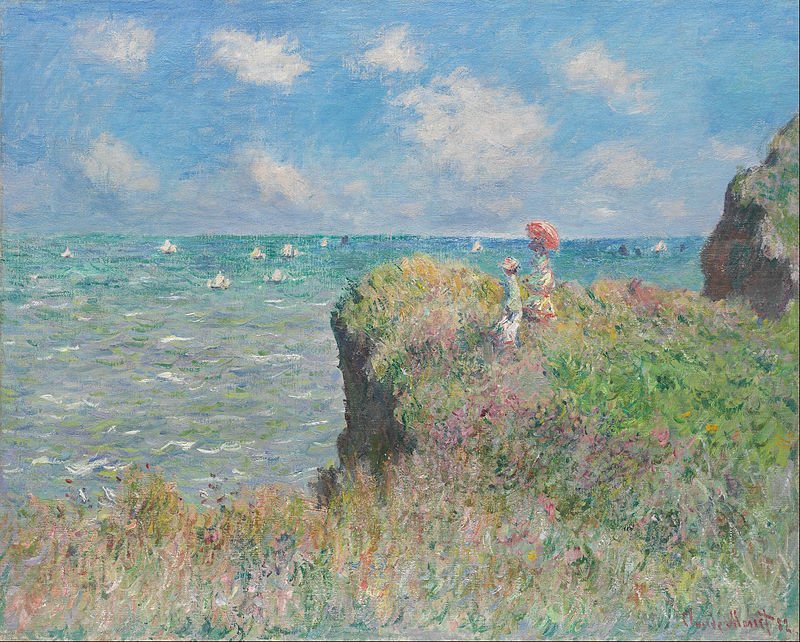
The Cliff Walk, Pourville, 1882, Art Institute of Chicago
Studies with Charles Gleyre
Upon leaving the foreign service in 1862, Claude Monet returned to Paris to join the private studio of Charles Gleyre, a painter of historical art. He shared studio space with Pierre-Auguste Renoir, Frederique Bazille, and Alfred Sisley, all of whom would later help determine the future direction of art. The students would often take their easels and paints to an outdoor setting and transfer their immediate impressions.
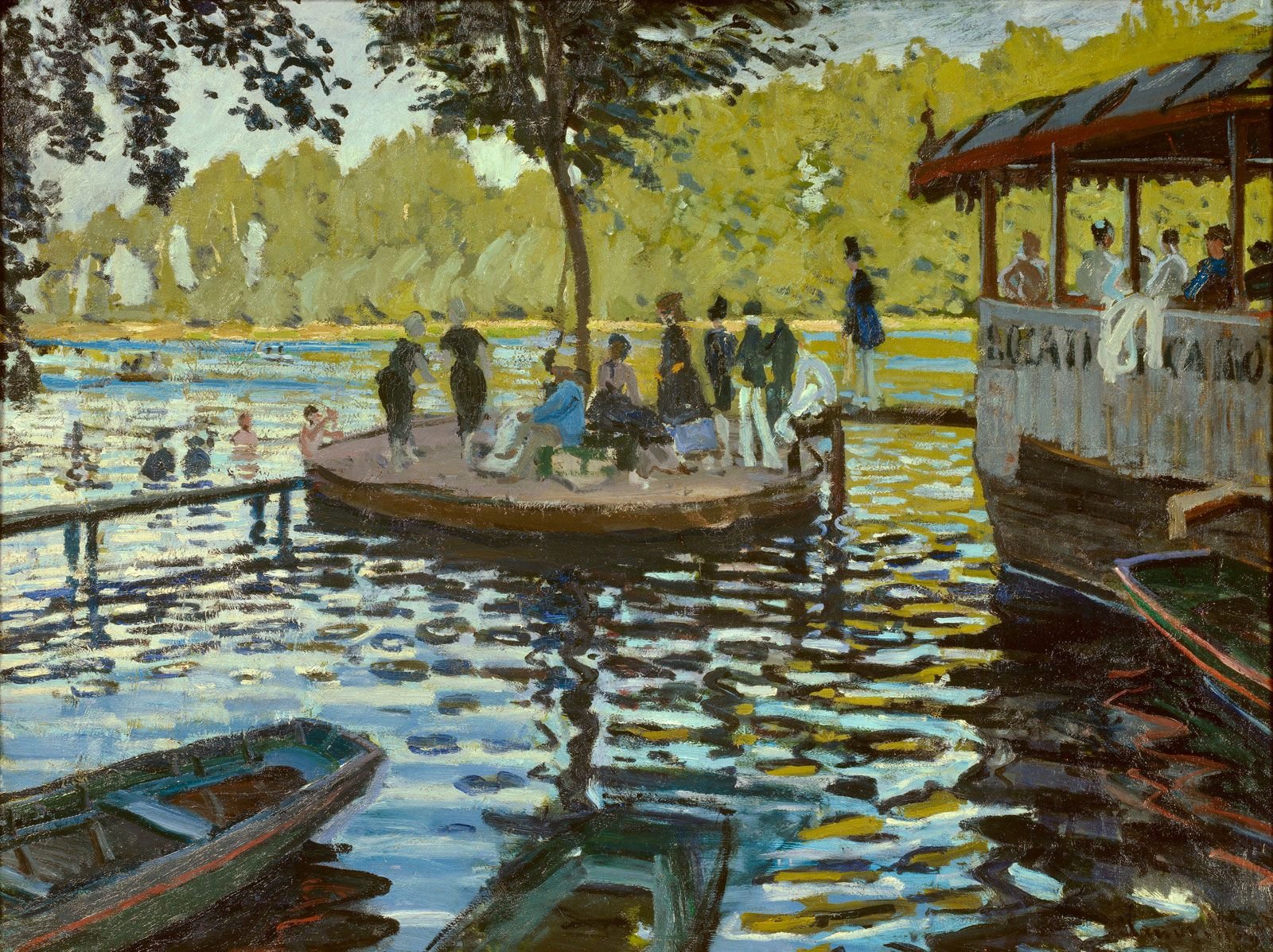
Le Grenouillere, 1867, Metropolitan Museum of Art, NYC
During his time as a student, at the Gleyre studio, Claude Monet painted “Woman in a Green Dress”, a life size portrait of his future wife Camille, and “Woman in a Garden”, for which Camille also modeled. The former painting was accepted for exhibit at the prestigious Paris Salon. The work was primarily in the realist style, lacking the blends of bright colors and the immediacy that would define his work later in his life.
Middle Years 1871 – 1900
After a June 1870 wedding, Claude Monet and his wife spent time in London, where the artist painted such works as “Hyde Park”. Afterward, the newlyweds stayed in the Netherlands where Monet produced several artworks.
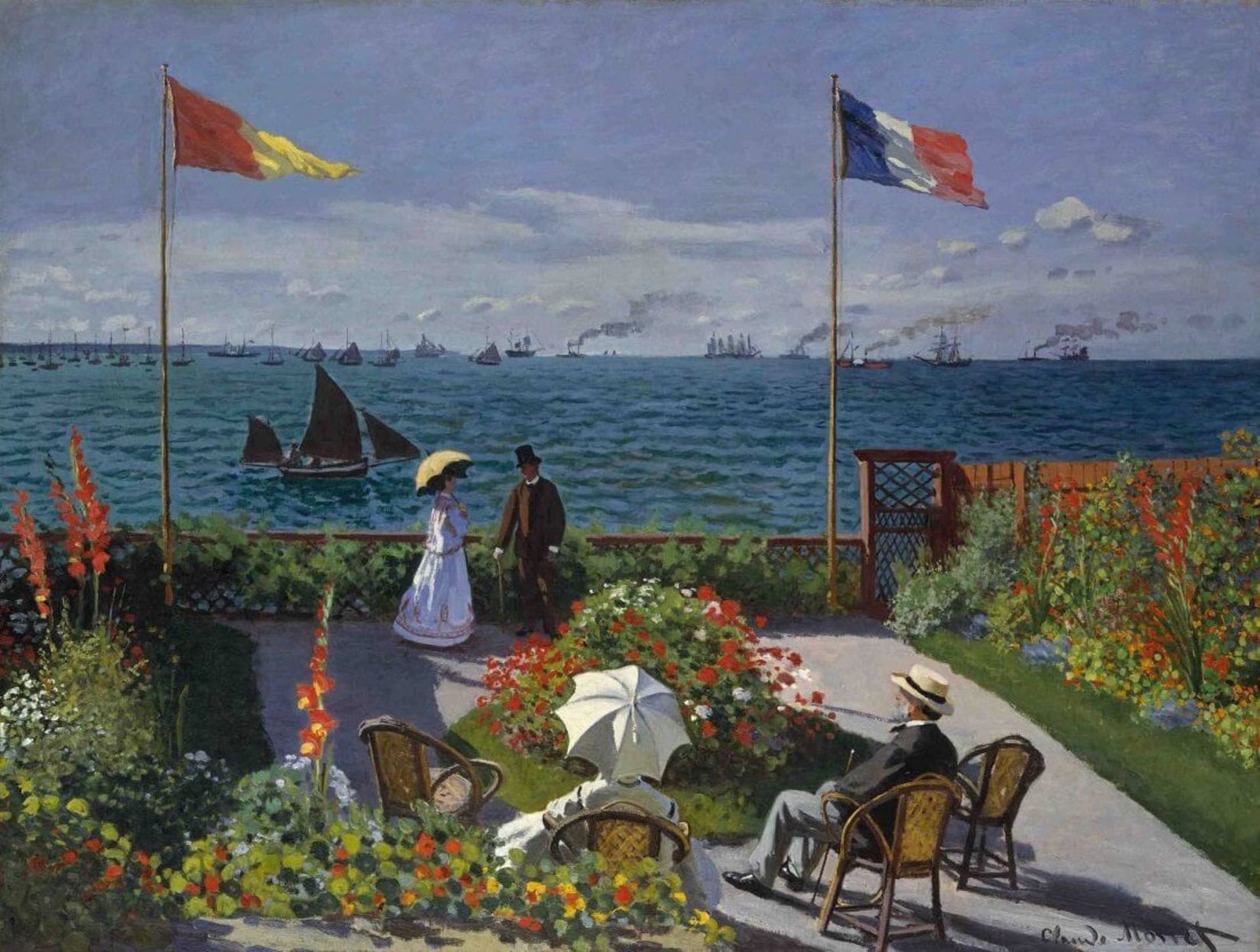
Garden at Sainte-Adresse, 1867, Metropolitan Museum of Art, NYC
Some of these works of art include, “The Windmill, Amsterdam” and the luminous, “Zaandam”. The couple returned to France late in the year, to make a home in Argenteuil on the right bank of the Seine, a Paris suburb where Camille would spend virtually the rest of her life. The artist acquired a floating studio where he painted the landscapes around him, as well as portraits of his friend Edouard Manet and his wife.
By the early 1880’s Monet and his artist friends, Paul Cezanne, Camille Pissarro, Sisley, and Edward Degas, had become disillusioned with the restrictive standards of the dominant arts organization in Paris, L’Academie des Beaus Arts, which selected the paintings to be included in the yearly Salons. In1873 they joined other likeminded colleagues to form their own arts organization.
“Société Anonyme Coopérative des Artistes Peintres, Sculpteures et Graveurs,” the group organised their first exhibit which included artwork of 30 artists in the spring of 1874. Monet opted to show his 1872 painting, “Impression Sunrise”, which proved to be a fateful decision. One art critic reviewing the exhibit coined the term “Impressionism” as a derisive jest after viewing “Impression Sunrise”.
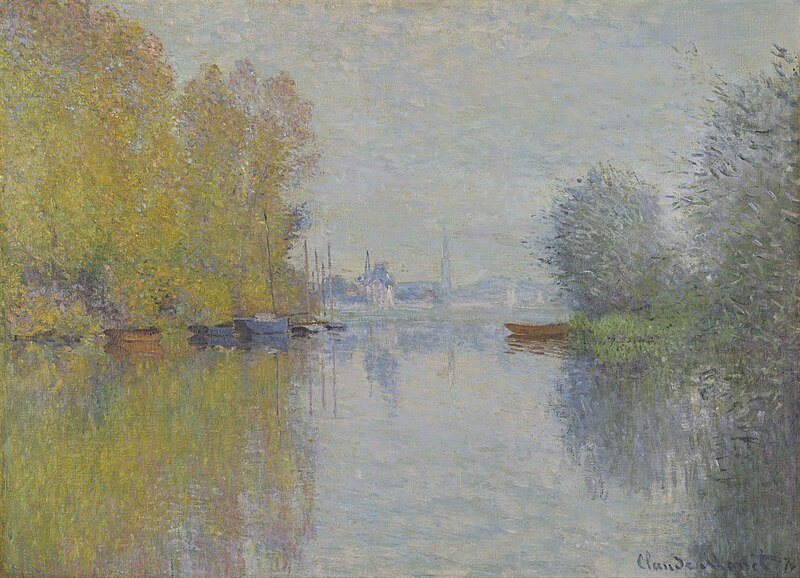
Autumn on the Seine at Argentruil, 1873, High Museum of Art, Atlanta
The artist embraced the new title for their movement, and thereafter, identified themselves as Impressionist. Once the movement had a name and a reputation, Monet went on to create some of his most brilliant works of art, such as “Madame Monet and Child” which he completed in 1875, a scene resplendent with and full of color and life.
A Time of Loss
While carrying their second child, Camille Monet contracted tuberculosis, and weakened by childbirth, died in 1879. The painting, “Camille on Jer Deathbed” is Monet’s final tribute to his wife, a figure covered in flower blossoms and feathery brush strokes, and her face was bathed in light.
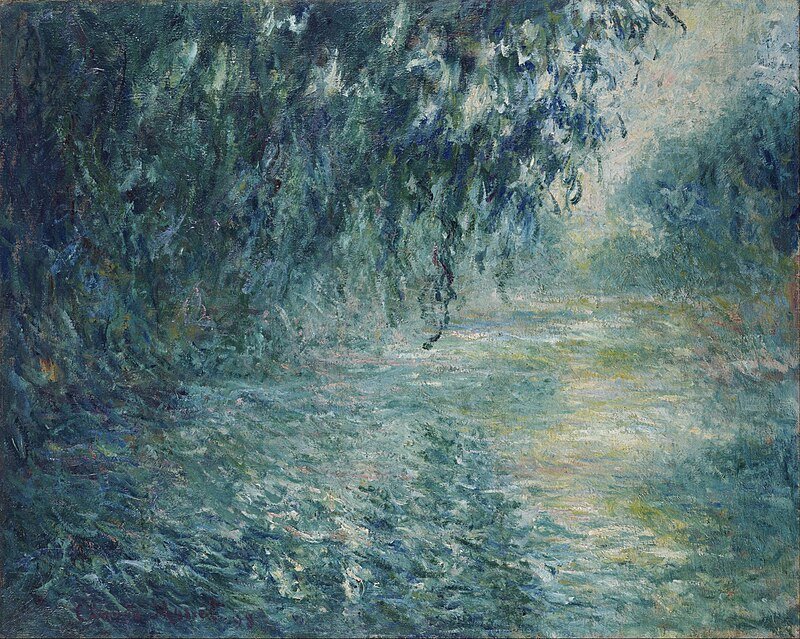
Morning On the Seine, 1898, National Musum of Western Art, Tokyo
Among the paintings he produced in the time of loss were “The Ice Drift Series” a group of a dozen paintings depicting the melting ice flows on the River Seine. Muted colors, denuded trees, and frozen landscapes reflecting the sorrow he had for his wife.
Claude Monet was becoming increasingly enamored with the insight that the same landscape underwent alterations at different times of the day as the sunlight changed. He painted the same scene repeatedly to capture these nuances on canvas. Along with “The Ice Drift Series” he added his “Haystack” paintings of the mid-1880’s and 1890’s.
In 1892 and 1893, the artist camped out in a rented room that overlooked the Rouen Cathedral to work on several canvases at once, each devoted to a different time of the day, to create intensive studies of light and shadow.
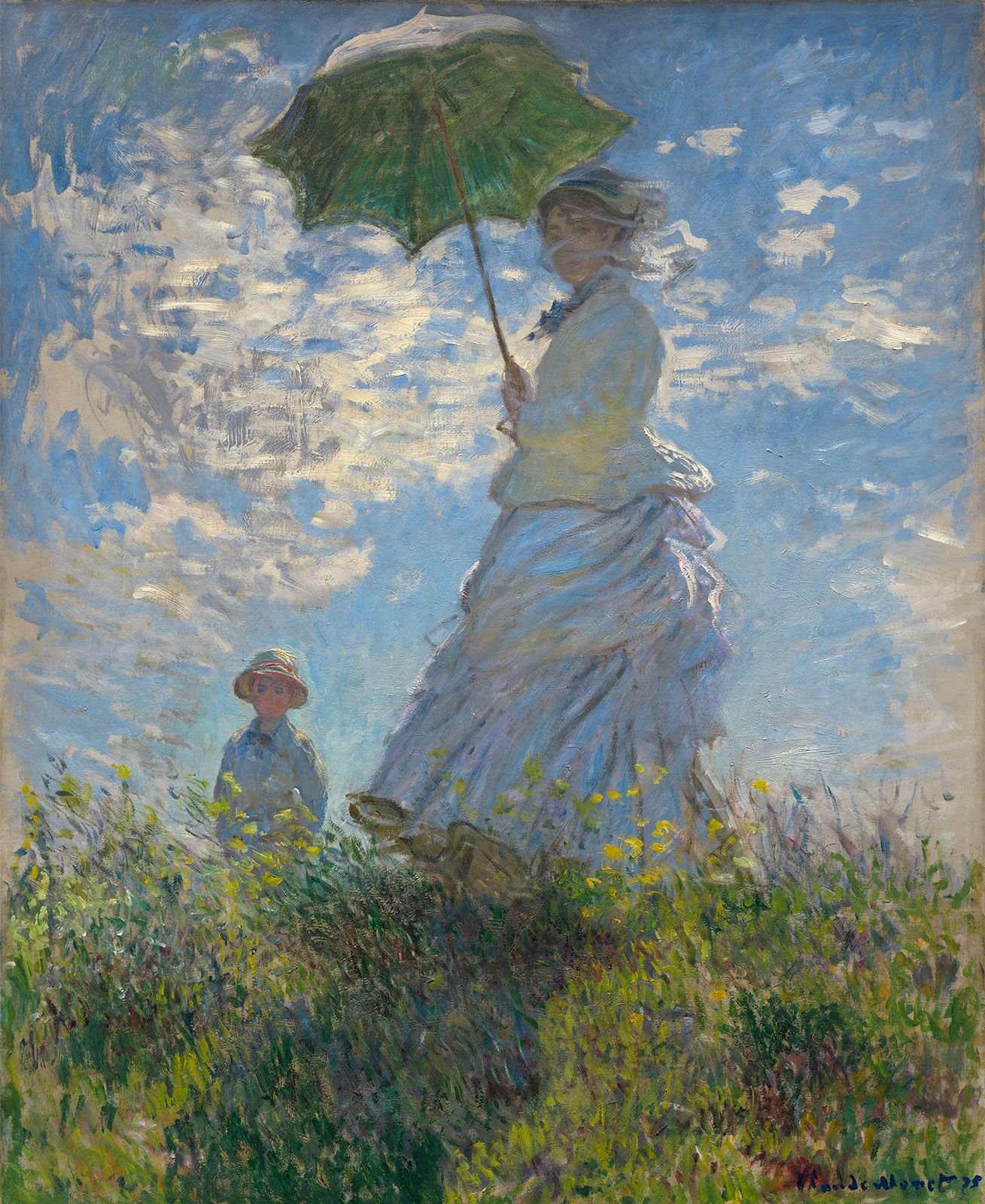
The Walk, Woman With a Parasol, 1975, National Gallery of Art, Washington DC
Style & Development
During this middle period in his artistic development, Monet’s artwork moved more towards abstraction, although the subjects were still recognizable, for the most part. He experimented with paint to create more depth of color but also texture to the surface of the canvas. Known for his innovated brushwork, Claude Monet utilized his signature short strokes and vibrant hues to encapsulate momentary glimpses of the effect of light on perspective.
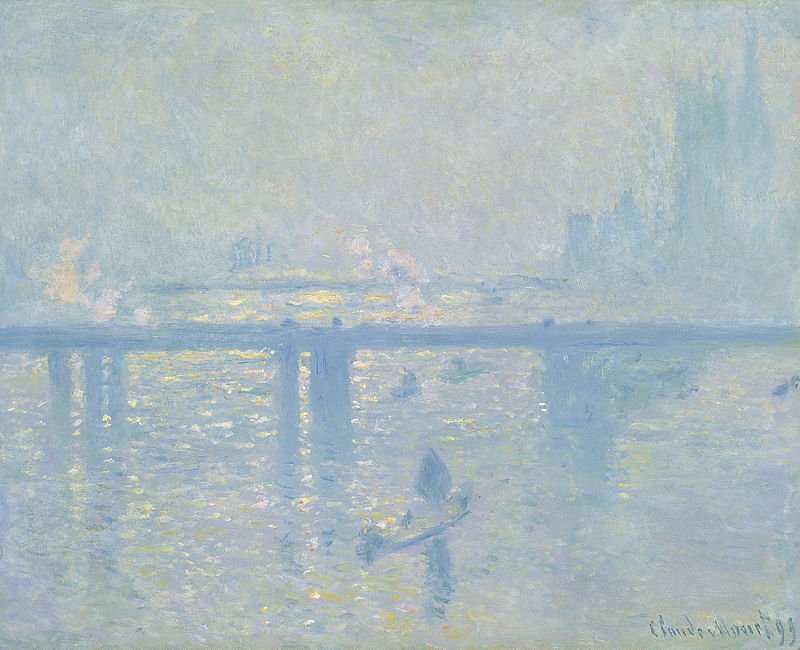
Charing Cross Bridge, 1899, Thyssen Bornemisza Museum, Madrid
Later Years 1901 – 1926
Claude Monet and his second wife, Alice, had moved into the Hamlet of Giverny where they bought a home with property in 1890. Monet set to work in a private haven where he would produce some of his most well-known works of art. Over his final decades of his life, flower gardens and lily ponds filled his cavass, with his most creative work he is still known for in modern times. Picturesque landscapes the artist would paint repeatedly as the century began. He would later state that the Giverny Gardens constituted his greatest work of art.
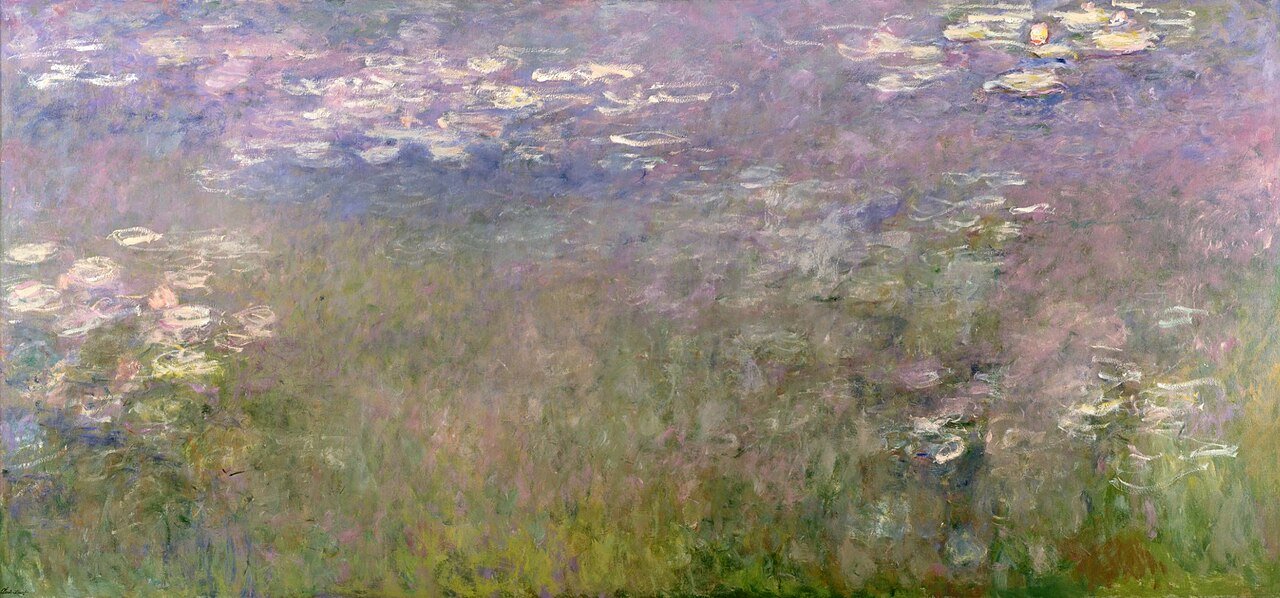
Water Lillies, 1915 – 1926, Nelson Arkins Museum of Art, Kansas City, MO
During his travels in the first decade of the 20th century, Claude Monet painted a series of the House of Parliament in the Palace of Westminster in London which raises over the fog or towers over the sun gilded waters. During the same period the artist produced several paintings in a study of the Waterloo Bridge and the Thames in various attitudes of light and fog. He also visited the Mediterranean region and Madrid in the early 1900’s.
Water Lilies
His chef d’oeuvre, however, was waiting for him in his own backyard where he produced his series of “Water Lily Pond” paintings, which consisted of approximately 300 canvases in total, 40 of them in large format. Claude Monet had painted his first renditions in the 1800’s but produced most of his work s during the final two decades of his life.
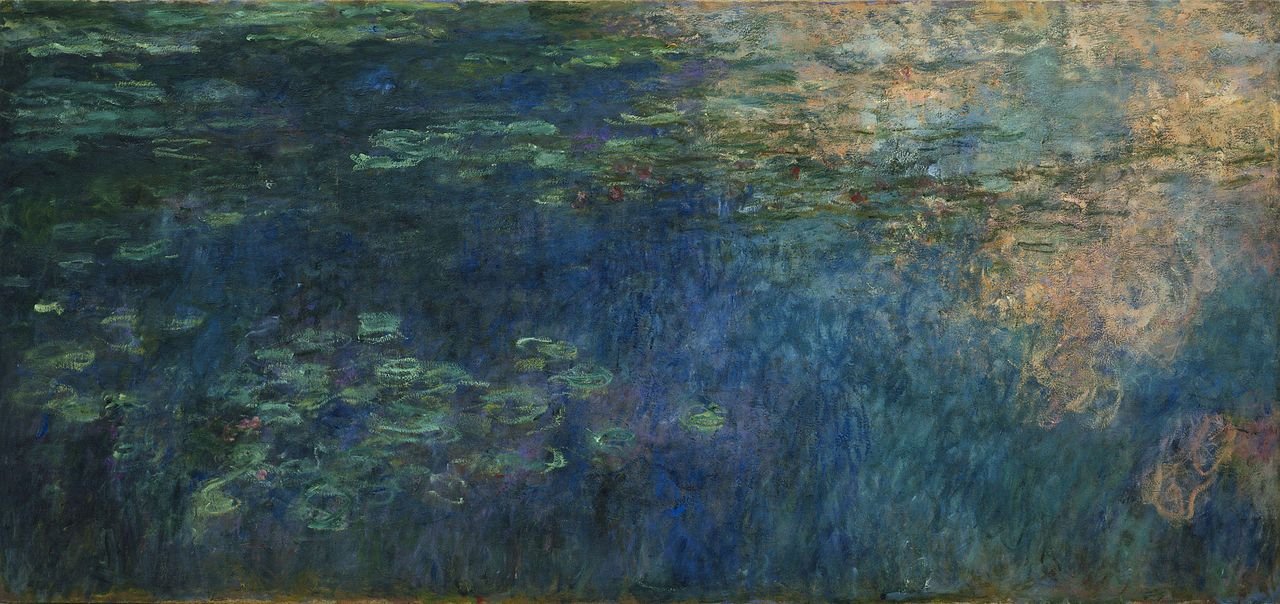
Reflection of Clouds on the Water Lily Pond, 1920, Museum of Modern At, New York
The early paintings of his lily pond included the conventional spatial boundaries of water, surrounded by land and horizon. As he progressed through these works of art, boundaries began to merge until finally the boundless pond became a universe, its scope immeasurable and defined exclusively by light.
In Conclusion
On Armistice Day in 1918, after his second wife and oddest son Jean Monet had passed away. He arranged to donate the resulting murals to the French State for installation in La Musee de l’Orangerie. Ever the perfectionist, the artist revised and reworked this series repeatedly over the ensuing years until their final installation in 1927, in two ovoid rooms of the artist design.
The opus includes eight room sized panels, each more than six feet tall, with lengths designed to fit the space. Andre Masson would christen these rooms “The Sistine Chapel of Impressionism” in a 1952 review.
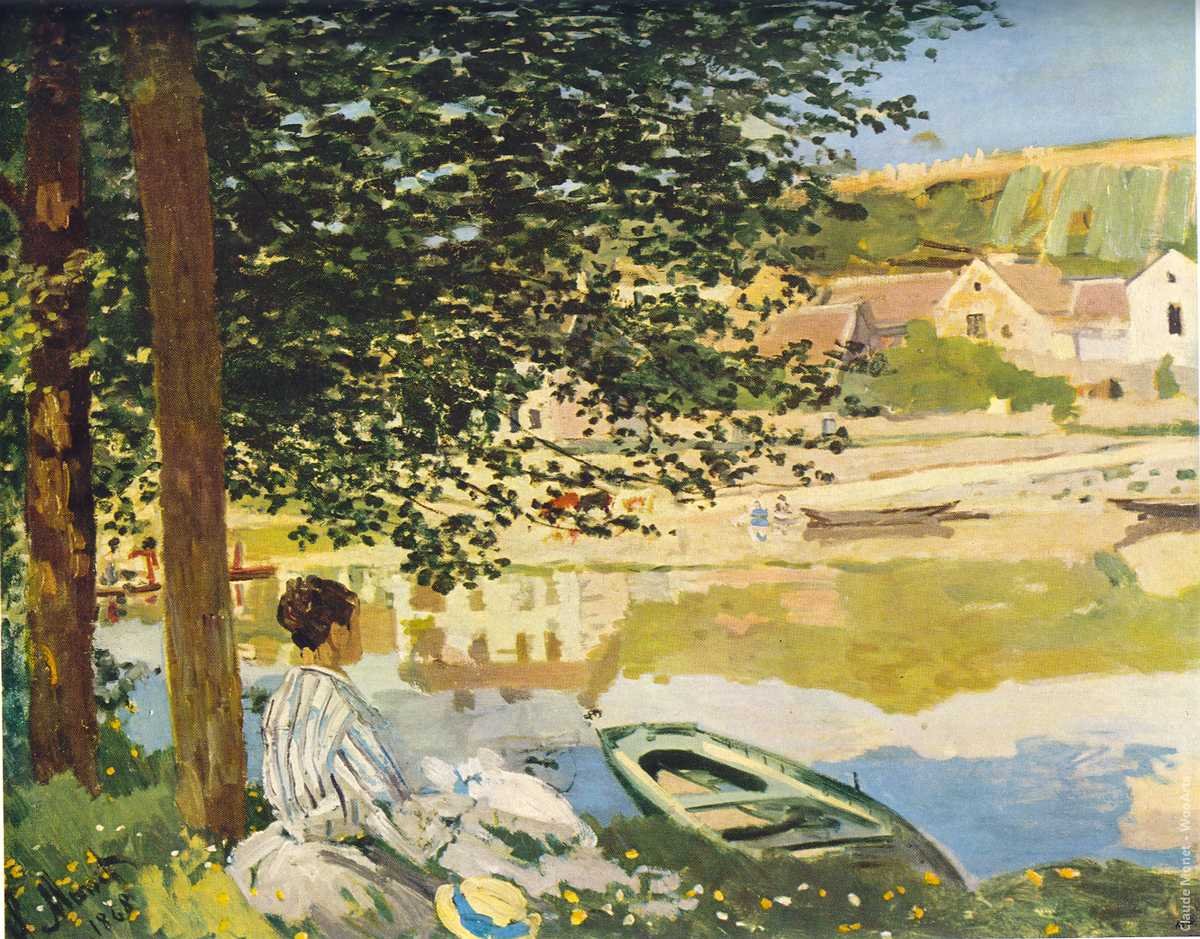
On the Bank of the Seine, 1868, Art Institute of Chicago
Just like William Shakespeare in literature and Mozart in music, Claude Monet’s impact on modern art is tremendous. Monet was among the most influential artists of any era, and his unique colors and vision made a lasting movement in the art world. Many artists have been influenced by Monet, such as Frederic Bazille, Alfred Sisley, Pierre-Auguste Renoir, Camille Pissarro, Vincent van Gogh, George Seurat, and Gustav Klimt. His legacy endures, he is extremely popular, and continues to this present day to define the public’s appreciation of art and his perception of beauty in its purest forms.
![La plage de Trouville, 1870, National Gallery, London. The left figure may be Camille, on the right possibly the wife of Eugène Boudin, whose beach scenes influenced Monet.[72]](https://aoidemagazine.com/wp-content/uploads/2025/08/la-plage-de-trouville-1870-national-gallery-lon.jpeg)
La Paige de Trouville, 1870, National Gallery, London
References
Art Institute of Chicago
Detroit Institute of Art
The Guggenheim Museum, NYC
Kimbell Art Museum, Fort Worth, TX
Metropolitan Museum of Art, NYC
Museum of Modern Art, NYC
National Gallery, London
Norton Simon Museum, Pasadena, CA
Philadelphia Museum of Art
Yale University Art Gallery
Claude Monet, Matthias Arnold, H Books, London, 2005.
Claude Monet, Hugh Brigstocke, Oxford University Press, 2001.
Monet: The Restless Vision, Jackie Wullaachlager, Allen Lane, London, 2023.



